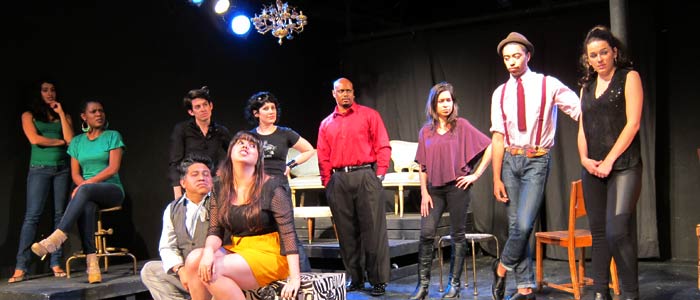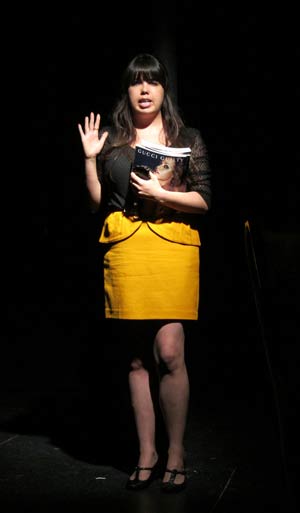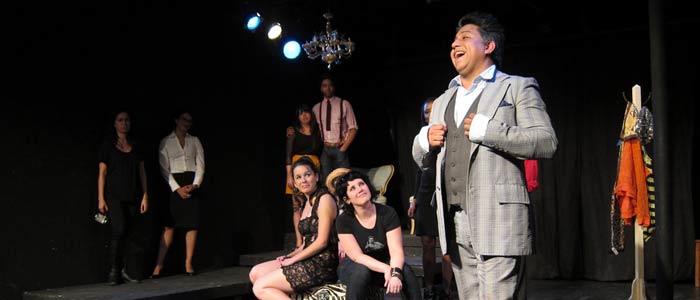Fa$hion | A World Premiere as part of The Alcyone Festival 2011 June 9 – July 10 2011.
At the Greenhouse Theatre Center 2257 N. Lincoln Ave. 773-404-7336
Erupting on stage is what feels like scores of pretty young people sashaying and spinning and twisting to the tunes of a DJ. Walking into that dark room with such festivities on display (there were still five minutes before the play was scheduled to begin) is like coming late to the party; you want to immediately lose yourself in the sea of dancers and join in to one of the more defendable acts of conformity, that of partying hard. Fighting the urge to yield to the beats was almost as futile as fighting a knee jerk, if for just an instant. But empty seats and some semblance of dignity beckoned.
Like effective opening credits to a movie or even the therapist’s swinging watch while on the proverbial couch, the revelry distracts you from yourself allowing you to enjoy what’s about to happen in front of you and really to you for the next 90 minutes: the play. Before I knew it, about 10 minutes had passed. When the first words broke the disco-ball pandemonium, it was truly a surprise for even as I was sitting in a chair, my mind was on stage heeding chord progression, lyric and the percussive hypnotics of both dancers and music alike.
In my startle, I melted in relief for such an orchestrated start suggests very intelligent design. And so, it took about ten minutes to decide that Coya Paz’s adaptation of a much older play – Fa$hion – would be something trustworthy as good and quite possibly great.
While the first words signaled the actual beginning of the play and concomitant end to the frivolity of the dancing and really to what could be considered the elevator music during waiting or transition, they arose with such musicality I felt the frisson that comes with the realization that there was no beginning or end but just transmuted dance.

Paz bombards the audience with a furious display of he-said-she-said-whodunit recall delivered at breakneck speed by a dazzling cast as numerous – initially – as glitter in the air. To be in the seats witnessing the execution of such an ambitiously choreographed performance provides a sensation well worth the ticket cost. Indeed, the characters attempting to relay just what happened – and what is assumed to be re-enacted for us – takes on the musicality indicative of playwriting at its best.

“A boy who wanted to be a girl.”
“A boy who actually really wanted to be a hummingbird.”
“Okay, so this girl—”
“This woman!”
“The woman and the girl?”
“No, the woman and the woman!”
“Like the woman and the woman!”
“Were they hummingbirds?”
“No, the woman and the woman were sisters.”
“The sisters?”
“Yeah, the sisters.”
“This story isn’t about the sisters.”
“It’s about the poet.”
“It’s about a hummingbird.”
“It’s about the girl.”
“It’s about the boy who liked the girl who liked the boy who liked the girl?”
“Mmm huh.”
“I’m confused.”
“Me too.”
“It’s about a woman and a woman and a boy and a girl and a boy who likes a girl and a girl who likes a girl and hummingbirds and sisters?”
“No!”
“Yeah!”
“Kind of.”
“You see, what happened was—”
“What happened was—”
“It’s complicated.”
Such a snapshot of the opening belies thorough exposition – even though this is a heavily pared down picture of Fa$hion. Having not read the original play by Anna Cora Mowatt in 1840, I cannot tell you if this opening was in its original form and therefore, reflective of no changes besides contemporary music and attire by the cast. What is reflective of Paz’s adaptation are the Herculean themes and social commentaries which are beautifully attained: the hipster lifestyle, sexuality, money, identity, love, family, betrayal and, of course, fashion.
And it is within this deceptively simple theme of fashion that all sorts of complexity resides for it becomes a metaphor. Youth in today’s world in which living within your means while trying to surf the vanguard of appearance is part of that word, fashion. Identity politics creep in when fashion becomes more than clothes but the lapel and hem and pleat of how others judge you and how you judge yourself. This means your sexuality becomes your fashion, your ethnicity becomes your fashion, your relatives become your fashion, and in a more lighthearted scene, your shoes can expose your possible racism.
Drunk Tweeting, pacifist gunpowder tea, racism-by-shoe, inability to wear purple – this humorous and clever writing captures with ease just how much has changed since Mowatt’s original and just how much has stayed the same.

Throughout the play, the DJ quietly lurks in the shadows of the stage evoking the presence of the omnipotent narrator. But instead of couching each scene with situational commentary, the DJ offers occasional music. Such ambient effects are all-at-once subtle and deafening for the role of DJ is to read the mood of what’s happening in the symbolic light of day and make of it, music.
Coya Paz was approached to adapt this play by Tony Adams, artistic director for Halcyon Theatre’s Alcyone ’11 Festival: Remixed. Besides creating great theater, the move by Adams and Halcyon was to address the absence of the ladies in the realm of theater, and then, of course, those marginalized voices who have no stage. Thankfully, Paz answered the call and in doing so, resurrected a voice quieted by time and the stupor that keeps such wonderful plays written by the likes of Anna Cora Mowatt away from their rightful place on the stage.